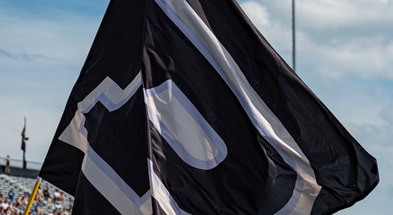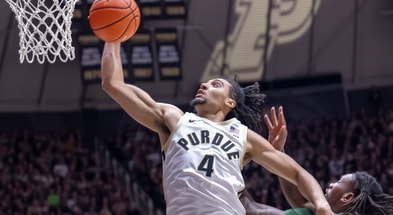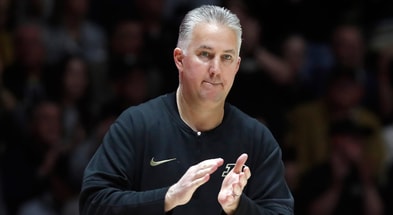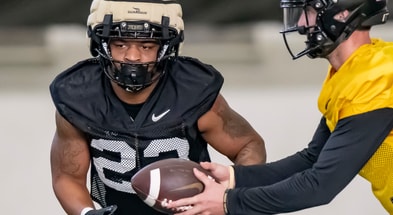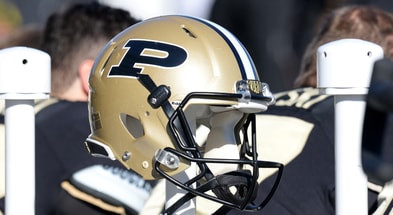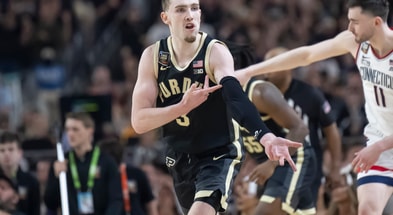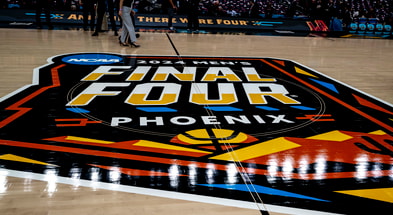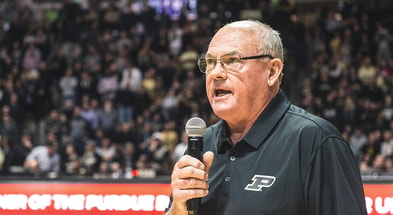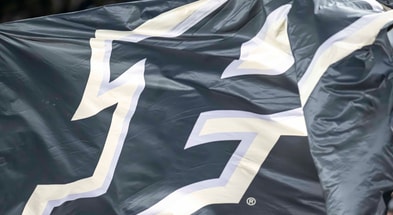Last year's Purdue greatest deficiency has become a strength
Purdue might be the most formidable three-point-shooting team in the country; one year ago at this time, it was one of the most vulnerable.
As the Boilermakers embark for the postseason after another outright and decisive Big Ten championship run and a regular season that framed Purdue as one of college basketball’s elite teams, they’ve been buoyed all season by an elemental turnaround of profound proportion.
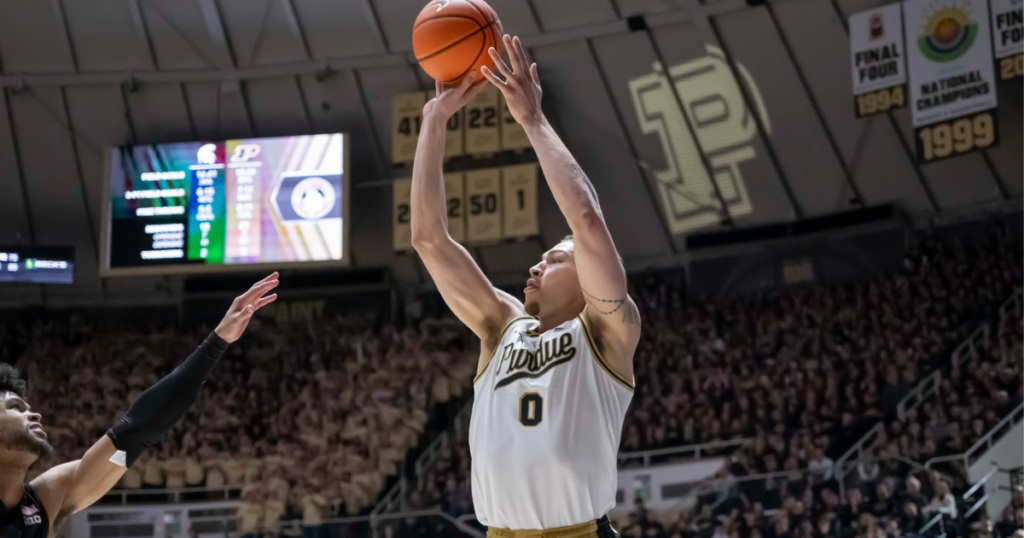
Last season, Purdue was one of the game’s biggest success stories prior to the NCAA Tournament, despite erratic snd sometimes just downright lousy three-point shooting, the very thing that ended its season in nightmarish fashion. How did Purdue become just the second No. 1 seed to ever lose to a 16 in the NCAA Tournament? It went 5-of-26 from three at the worst possible moment.
With a roster built to shoot and a generational player in Zach Edey needing help from the perimeter, Purdue left pounds and pounds and pounds of meat on the bone last season by shooting just 32.2 percent from three. There were 275 teams in college basketball that shot better, none of which had Edey and few of which had the sort of offensive-skill assets Purdue believed in until the very end.
The pay-off has come now.
Purdue’s spent the whole season as one of the best-by-percentage shooting teams in America. Kentucky shoots a tenth of a percentage point better but that’s a breadcrumb of a margin between Nos. 1 and 2 nationally.

If the season ended today, Purdue’s success rate of 41.1 percent would represent the fourth-best single-season clip since the three-pointer became part of college basketball. The top three marks currently are 1988 (44 percent), 2018 (42) and 1987 (41.2).
Purdue has generated 30.5 percent of its points from beyond the arc this season, up only slightly from last season’s 28.2 percent, but has been much more efficient and much more consistent.
The Boilermakers expected to be better this season as their young guards from last season settled in even more. And, truth be told, there was nowhere to go but up.
But a jump of this magnitude has been an eye-opener.
How did it happen?
IT IS PRETTY OBVIOUS
Prior to this season, Purdue’s collective stance was that players generally make the biggest jumps between their first and second seasons. Matt Painter pointed to several former Big Ten standouts for whom that was the case.
It was his expectation for Fletcher Loyer and Braden Smith, each of them now sophomores and better conditioned in all senses of the term for a full college season.
Loyer last season on an average of 5.2 attempts per game: 32.6 percent.
Loyer this season on an average of 3.9 attempts per game: 43.3 percent. He shot an astronomical 49 percent during the Big Ten regular season and closed said season having made eight of his last 11, as Purdue closed the season with a trio of Quad 1 victories.
For Loyer, less has been more.
“The game’s slowed down for us,” Loyer said. “Last year, you’d get a little rushed, and think ‘I’ve gotta shoot this one, or shoot that one, or do this,’ but now it’s all just falling into our hands and we’re taking advantage of what comes to us.”
For Loyer’s classmate, Smith, more has been more.
Smith is attempting 3.3 threes per game this season, and has knocked down 44.6 percent. Last season, he attempted 2.9 threes per game and made 37.6 percent, which was pretty good and far from Purdue’s problem then, but now proving to be merely Smith’s starting point.
“This year we know where our shots are going to come from,” Loyer said. “… Working on the shots we’re going top get in games and seeing it translate has been huge.”
WEAPONIZING BRADEN SMITH … AND MASON GILLIS
After last season, Purdue conveyed its message to Braden Smith in no uncertain terms: Score.
The point guard has abided and the effects have rippled through the entire season, changed Purdue’s offense and made it one of the toughest guards and most potent units in the college game. Smith as a scoring threat opened up Purdue’s whole offense, starting with his play in Honolulu, where Purdue won the Maui Invitational.
According to Synergy Sports, 13 percent of Purdue’s offensive plays this season have involved a pick-and-roll/ball-screen element, almost exclusively led by Smith. One those plays, it’s 20-of-46 on three-point shots. Last season, 10 percent of its possessions were driven by a pick-and-roll. Purdue was 15-of-51 from three on those plays.
Now, it is important to understand that such data has grey areas, because a ball screen can be part of Purdue’s basic motion and not necessarily be a primary action, and pick-and-roll frequently ends in a post-up and thus may be categorized as such.
But the added ball-screen element has changed Purdue, a great offense last season that’s gone to another level now. KenPom has Purdue as the No. 1 offense in college basketball in terms of efficiency.
Smith will pull up and shoot. He’s 13-of-34 shooting out of pick-and-roll and especially effective turning down screens and creating iso or spot-up opportunities. Then there’s ability to utilize the threat he poses to generate ideal shots for others, whether it’s been cross-court darts that hit shooters square in the hands or the simple pass out of a trap.
Maybe the prime beneficiary this season: Mason Gillis. The Boilermaker 4 man is an absolutely essential piece of many of Purdue’s ball-screen sets, generally as the roll-and-replace “indirect” who cuts to the top of the arc, the space just vacated by Edey, to set up either an open three or a middle post entry.
Gillis is shooting 49 percent from three for the entire season.
“Playing the right way and getting better shots, that helps our percentages, too,” Gillis said. “We’re not taking contested shots. Zach’s going a great job passing out of the post. There are a lot of things that add up to us being a great three-point shooting team.”
LANCE JONES
After his final season at Southern Illinois last year, Lance Jones conceded he may have “settled” for too many threes, attempting almost eight per game and making only 28 percent.
There was no way that volume was going to even come close to such levels as a complementary piece at Purdue, right?
Well …
Jones is attempting six per game, far and away the most on the team, but he’s made a rock-solid 36-and-a-half percent of them, including a number of last-moment-throwaway misses (and one make).
He’s been aggressive, for better and worse at times, but critical, including in transition. He’s 13-of-19 on transition threes this season; collectively, Purdue shoots 43 percent on transition triples, per Synergy.
Sustainability questions regarding Jones’ volume would have been a question for six weeks ago, but his numbers always even out and his fearlessness has been a net posive for his new team’s personality.
ZACH EDEY’S IMPROVEMENT
Zach Edey averages less than two assists per game, but that number is barely relevant when gauging his impact as a passer this season, the product in part of experience and chemistry with this cast around him. People may forget that last season was Edey’s first ever as the best player on his basketball team and the focal point for opposing defenses.
This isn’t new anymore, and it has clearly shown, whether it be a direct assist, the hockey assist — he played hockey, you know — or simply the pass out that gets the defense moving around. Some of Purdue’s most pristine offense this season has involved Edey and an entry man just pinging the ball back and forth into and out of the post.
“He was a terrible passer when he got here,” Painter said. “Now he’s a great passer, but he’s always been a willing passer.”

